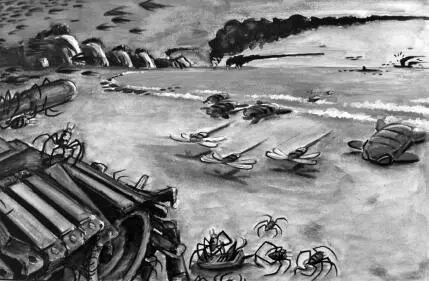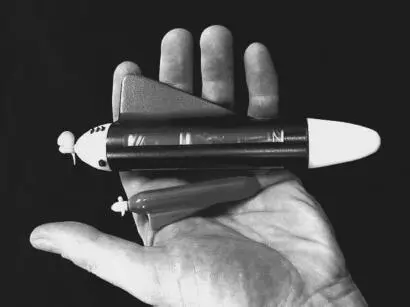But learning or evolving software only takes you so far. The next step will be to have adaptation of the body, the hardware itself, by setting up selection to act on a population of Evolvabots. “Hod Lipson is the state-of-the-art for mechanical adaptation,” explained former student and now colleague Josh de Leeuw. I agree. Hod, associate professor of many things (engineering, computer science, robotics) at Cornell University, takes a bio-inspired approach in order to engineer machines that can build other machines. Hod’s lab has designed and built embodied robots automatically from digitally evolved scenarios and, along with his colleague Josh Bongard, assistant professor in computer science at the University of Vermont, created robots that sense self-injury and respond by altering their body and behavior. [206] Two groundbreaking papers by Lipson that you simply must read: H. Lipson and J. B. Pollack, “Automatic Design and Manufacture of Artificial Lifeforms,” Nature 406, no. 6799 (2000): 974–978; and J. Bongard, V. Zykov, and H. Lipson, “Resilient Machines Through Continuous Self-Modeling,” Science 314, no. 5802 (November 2006): 1118–1121.
Bongard takes an approach that he calls “artificial ontogeny,” allowing a robot to combine learning over its lifetime while it is embedded as an individual in a population of evolving robots. [207] Bongard explains his approach on his web page: www.cs.uvm.edu/~jbongard/research.html.
At first, the idea of machine-making machines—replicating themselves, reproducing novel offspring, or making offspring for someone else—may seem far-fetched. But as Adam Lammert, one of the inventors of Tadro (see Chapter 3), pointed out to me recently, self-replicating machines were shown to be feasible as early as 1957. [208] Penrose the Elder summarized their work in this article: L. S. Penrose, “Self-Reproducing Machines,” Scientific American 200, no. 6 (June 1959): 105–114.
Lionel and Roger Penrose, at the University College, London, demonstrated that recognition systems and subunits needed for replication could be built into the body of a physically embodied model organism. These models, made of plywood, were “creatures” with levers that prevented joining other creatures unless the proper mechanical signature was present. Once conjoined, two creatures, or a creature and subunits, could undergo fission to create two replicants. [209] You can watch the Penrose machines replicating in this film, made in 1961: http://vimeo.com/10298933.
Today Hod uses rapid-prototypers, machines that create three-dimensional parts of nearly any size and shape from software instructions.
Thus, the final step in making military robots will be to have them make their own robotic offspring as part of evolution on the battlefield. Robots will evolve their brains and bodies in response to the dynamic chaos of the moment in order to carry out their longer-term mission. Evolutionary adaptations will occur in a population of military Evolvabots with feedback from the battlefield environment using a fitness function the battlefield commanders generate. That fitness function might reward performance such as rate of target detection, rate of target hit, probability of survival, and robustness, or the ability to continue to operate once damaged.
When I presented this fitness idea to Chuck Pell, he disagreed: “The basic principle for robots in war should be this: [robots should be] unmanned, expendable, and cause maximum damage.” When I pointed out that a simple fitness function of maximum damage doesn’t leave room for evolving very complicated robots, he said that was the point. Chuck’s perspective is that complicated robots are expensive, and that’s a problem. With expensive robots, he explained, commanders won’t want to lose them, and those in charge will alter their tactics accordingly. The inescapable consequence, which I’ll call Pell’s Principle, “is that robot capabilities are proportional to cost, and cost is inversely proportional to expendability.” The logical conclusion of Pell’s Principle is to build and use swarms of simple, small, expendable robots (Figure 8.2).

FIGURE 8.2. Pell’s Principle in action. Swarms of simple, expendable robots overwhelm more complicated systems. In any environment swarms succeed by getting close and manipulating sensors, motors, and communications. The robotic systems represented here are based on real systems under development. Note the bio-inspired and diverse designs. Watercolor pencil sketch by Charles Pell.
“You can’t stop all the little robots,” said Chuck, “robots like MicroHunter.” [210] MicroHunter was invented by Chuck Pell, Hugh Crenshaw, Jason Janet, and Mathieu Kemp and was assigned to Nekton Technologies, Inc., US Patent 6,378,801. C. Pell, H. Crenshaw, J. Janet, and M. Kemp, “Devices and Methods for Orienting and Steering in Three-Dimensional Space,” 2002. A great place to get an overview of MicroHunter is in J. Wakefield, “Mimicking Mother Nature,” Scientific American 286, no. 1 (January 2002): 26–27.
MicroHunter was a microAUV (Autonomous Underwater Vehicle) built using the same cycloptic helical klinotaxis system that we used to build Tadro (Figure 8.3; MicroHunter was introduced in Chapter 4). But whereas Tadro is a surface swimmer, MicroHunter swims underwater, spiraling its way to a light source from anywhere you could put it in an Olympic-sized pool. MicroHunter, funded by a DARPA contract to Chuck as an employee of Nekton Research (see Chapter 7), and Hugh Crenshaw, then professor at Duke University, caught their program officer’s eye when the duo reported that it had a 100 percent success rate finding the target. [211] For more on MicroHunter, see M. Kemp, H. Crenshaw, B. Hobson, J. Janet, R. Moody, C. Pell, H. Pinnix, and B. Schulz, “Micro-AUVs I: Platform Design and Multiagent System Development,” in Proceedings of the 12th International Symposium on Unmanned Untethered Submersible Technology (UUST) , 2001.
“Nothing is ever that good,” said Chuck, “so they sent statisticians and a former Navy SEAL to investigate.”
SEALs, the US Navy’s special operations experts, are world renowned for their abilities underwater. [212] For more on Navy SEALs, see their website: www.navyseal.com/navy_seal/.
So even though Chuck and Hugh knew that MicroHunter could hit the three-meter light target when unchallenged, they figured that a group of four MicroHunters, swimming slowly, wouldn’t stand a chance with a special ops SCUBA diver in the pool. To everyone’s surprise and the SEAL’s chagrin, the MicroHunters and the SEAL played to a draw, with the MicroHunters hitting the target 50 percent of the time in six three-minute trials. That’s seriously excellent performance for a piece of embodied intelligence with but a single sensor and a single degree of freedom on the motor output side. Now try to imagine defending against not just four MicroHunters but a swarm of fifty. Your only defense may be evolution.

FIGURE 8.3. MicroHunter, a fully autonomous micro-aquatic robot with just one moving part, a propeller. MicroHunters, seven-and seventy-gram versions shown here, were developed by researchers and engineers at Nekton Research and Duke University with funding from DARPA’s MicroSystems Technology Office, Distributed Robotics Effort. Photo by Charles Pell.
Читать дальше














